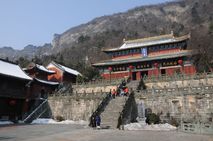Wudang Mountains
| Ancient Building Complex in the Wudang Mountains* | |
|---|---|
| UNESCO World Heritage Site | |
 |
|
| State Party | |
| Type | Cultural |
| Criteria | i, ii, vi |
| Reference | 705 |
| Region** | Asia-Pacific |
| Inscription history | |
| Inscription | 1994 (18th Session) |
| * Name as inscribed on World Heritage List. ** Region as classified by UNESCO. |
|
The Wudang Mountains (simplified Chinese: 武当山; traditional Chinese: 武當山; pinyin: Wǔdāng Shān), also known as Wu Tang Shan or simply Wudang, are a small mountain range in the northwestern part of Hubei Province of People's Republic of China, just to the south of the city of Shiyan.
Contents |
Geography
On Chinese maps, the name "Wudangshan" (武当山) is applied both to the entire mountain range (which runs east-west along the southern edge of the Hanshui River valley, crossing several county-level divisions of Shiyan Prefecture-level city), and to the small group of peaks located within Wudangshan Jiedao of the Danjiangkou County-level City of the Shiyan Prefecture-level city. It is the latter specific area which is known as a Taoist center.[1]
Modern maps show the elevation of the highest of the peaks in the Wudang Shan "proper" as 1612 meters;[1][2] however, the entire Wudangshan range has somewhat higher elevations elsewhere.[1] Some consider the Wudang Mountains to be a "branch" of the Daba Mountains range,[2] which is a major mountain system of the western Hubei, Shaanxi, Chongqing and Sichuan.
History
In years past, the mountains of Wudang were known for the many Taoist monasteries to be found there, monasteries which became known as an academic centre for the research, teaching and practise of meditation, Chinese martial arts, traditional Chinese medicine, Taoist agriculture practices and related arts. As early as the Eastern Han Dynasty (25–220 AD), the mountain attracted the Emperor's attention. During the Tang Dynasty (618–907), the first site of worship—the Five Dragon Temple—was constructed. Some of the monasteries were damaged during and after the Cultural Revolution of 1966–1976, but the Wudang mountains have lately become increasingly popular with tourists from elsewhere in China and abroad due to their scenic location and historical interest. The monasteries and buildings were made a UNESCO World Heritage Site in 1994. The palaces and temples in Wudang, which was built as an organized complex during the Ming Dynasty (14th–17th centuries), contains Taoist buildings from as early as the 7th century. It represents the highest standards of Chinese art and architecture over a period of nearly 1,000 years. Noted temples include the Golden Hall, Nanyan Temple and the Purple Cloud Temple.
On January 19, 2003, the 600-year-old Yuzhengong Palace at the Wudang Mountains was accidentally burned down by an employee of a martial arts school.[3] A fire broke out in the hall, reducing the three rooms that covered 200 square metres to ashes. A gold-plated statue of Zhang Sanfeng, which was usually housed in Yuzhengong, was moved to another building just before the fire, and so escaped destruction in the inferno.[4]
Association with martial arts



According to legend, Zhang Sanfeng (张三丰), is the originator of Wudangquan generally and Taijiquan specifically. He was said to be inspired by a fight he witnessed between a pied magpie (also said to be a white crane) and a viper.
From the early 20th century, Taijiquan, Xingyiquan and Baguazhang have been considered Wudang styles, following Sun Lutang. Following this classification the national martial arts tournament of the Central Guoshu Institute held in 1928 separated the participants into "Shaolin" and "Wudang".
The third biannual Traditional Wushu Festival was held in Wudang Mountains from October 28 to November 2, 2008.[5]
See also
- Taijiquan
- Tao Yin
- Wudangquan
- Wudang Sect
- Xuan Wu
- Yang Lu Chan
- Zhang Sanfeng
References
- ↑ 1.0 1.1 1.2 Road Atlas of Hubei (湖北省公路里程地图册; Hubei Sheng Gonglu Licheng Dituce), published by 中国地图出版社 Zhongguo Ditu Chubanshe, 2007, ISBN 978-7-5031-4380-9. Page 11 (Shiyan City), and the map of the Wudangshan world heritage area, within the back cover.
- ↑ 2.0 2.1 "Wudang Mountains", Atlas of World Heritage: China, Long River Press, 2008, pp. 89–90, ISBN 1592650600, http://books.google.com/books?id=tFRgajxu3wIC&pg=PT99
- ↑ "China's world heritage sites over-exploited". China Daily. December 22, 2006. http://www.chinadaily.com.cn/china/2006-12/22/content_765749.htm. Retrieved 2008-04-19.
- ↑ Wang, Fang (May 11, 2004). "Pilgrimage to Wudang". Beijing Today. http://www.chinadaily.com.cn/english/doc/2004-05/11/content_329676.htm. Retrieved 2008-04-19.
- ↑ 李, 鹏翔 (April 18, 2008). "第三届世界传统武术节将在湖北十堰举行". 新华社稿件. http://www.pladaily.com.cn/site1/xwpdxw/2008-04/18/content_1209982.htm#. Retrieved 2008-04-19.
External links
- UNESCO World Heritage Sites descriptions
- International Wudang Federation(including training in Wudangshan)
|
|||||||
|
||||||||
